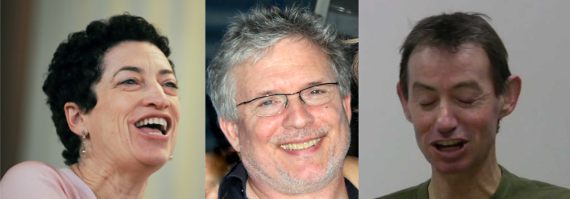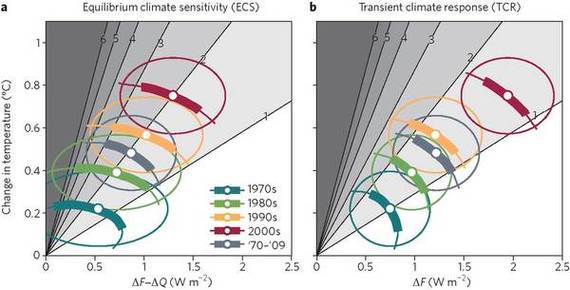 Bishop Hill
Bishop Hill Another Lew paper
 Sep 16, 2015
Sep 16, 2015  Climate: sensitivity
Climate: sensitivity  Stefan Lewandowsky's latest paper is out today in the Bulletin of the American Meteorological Society and features none other than Naomi Oreskes as a co-author, with the scientific oomph coming from CSIRO's James Risbey. With a roster of authors like that I think it's fair to say that one knows what to expect.
Stefan Lewandowsky's latest paper is out today in the Bulletin of the American Meteorological Society and features none other than Naomi Oreskes as a co-author, with the scientific oomph coming from CSIRO's James Risbey. With a roster of authors like that I think it's fair to say that one knows what to expect.
The paper is about the pause in surface temperature rises and is an attempt to demonstrate that it doesn't exist. Not very interesting I hear you say. However, the paper is not without its moments of controversy. In particular, this paragraph jumped out at me.
...some researchers (albeit a minority) have taken the “pause” to imply that the climate system may be less sensitive to greenhouse gas emissions than previously thought (Lewis 2013; Otto et al. 2013; Curry 2014; Lewis and Curry 2014).
What is clear from this is that Lewandowsky and Oreskes don't understand the energy budget studies. As Nic Lewis has pointed out before, you would expect climate sensitivity estimates obtained this way to be unaffected by the pause:
In principle, the lack of warming over the last ten to fifteen years shouldn't really affect estimates of climate sensitivity, as a lower global surface temperature should be compensated for by more heat going into the ocean.
What is truly remarkable is that Lewandowsky et al have managed to read all of the four publications they cite without noticing that this stability with respect to the period under consideration is prominently discussed in them. In fact in Otto et al it was pretty much the whole point of the paper. In other words, the papers cited by them say precisely the opposite of what Lewandowky et al says they do. Otto et al had one diagram in it, which showed that you get low climate sensitivity no matter what end period is chosen. Indeed the ECS estimate based on a 2000s end period is higher than the one based on a 1990s end period.
 The stability of the climate sensitivity estimate under different end periods is discussed in Lewis and Curry 2014:
The stability of the climate sensitivity estimate under different end periods is discussed in Lewis and Curry 2014:
[Otto et al.] yielded encouragingly stable estimates for ECS using final periods of 1980-89, 1990-99, 2000-09 and 1970-2009, with medians of 2.0 K when using 2000-09 data and 1.9 K otherwise.
And as for Lewis 2013, well that paper didn't even cover the pause:
We present results using the F06/SFZ08 five decade to 1995/96 surface diagnostic data so as to provide accurate comparisons with the F06 results. We also present results using a revised, extended surface diagnostic with correctly matched model and observational data for the six decades to 2001, using a nine decade climatology to 1991 to compute temperatures anomalies.
Curry 2014, the last of Lewandowsky's citations, is an editorial in the Wall Street Journal, which contains this:
...the estimates in [the] empirical studies are being borne out by the much-discussed “pause” or “hiatus” in global warming—the period since 1998 during which global average surface temperatures have not significantly increased.
Which again is not what Lewandowsky said she is claiming.
I conclude, therefore, that this part of the paper by Lewandowsky, Risbey and Oreskes is a complete fabrication.
 Bishop Hill
Bishop Hill
In the comments, Nic Lewis includes this quote from Lewis and Curry 2014:
It has been claimed (Rogelj et al, 2014) that the results of recent studies pointing to ECS being lower than the IPCC AR4 range (2–4.5 K) are strongly influenced by the small increase in observed warming during the last decade, although that is factually incorrect for all four of the studies it cited (Schmittner et al 2011, Aldrin et al 2012, Lewis 2013 and Otto et al 2013). Results here using final periods ending in 2000-2003 instead of 2011 do not support such claims either for ECS or for TCR



Reader Comments (57)
"any economist worth their salt should have immediately spotted the graph is not what was claimed because agricultural output did not have a peak in 1940s during WWII."
I have never before considered victory gardens being analogous to volcanoes......but I bet that Lew et al would try.
Naomi looks like a braying horse, and Rigby is Gollum! How come Lewandowsky looks so good. Surely there must be a file photo that shows him as he really is!
lets not forget Bristol "university" stats professor Stephan Lewandowsky comes to scientific conclusions on datàsets with , erm, ÑO samples in it.
not "not enough" or "statistically insignificant" data or something..
no.
data with NO datà in it
This paper by the three notables above is another attempt to prove the non-existence of the present hiatus. For the information of these alleged climate scientists, they now have two hiatuses to deal with, not one. The first one occurred in the eighties and nineties but you can not see it on official temperature records because they have been falsified. While doing research for my book "What Warming?" in 2008 I used satellite data and discovered the existence of this former hiatus. But when I went to cross check with official land-based temperature curves it was nowhere in sight .What was in sight was a fake temperature rise they called "late twentieth century warming." No warming there, just a complete lack of warming according to satellites. It lasted from 1979 to 1997, an 18 year stretch like the current one.
A further investigation showed that HadCRUT3 was the source of this cover-up. I even put a warning about it into the preface of the book when it came out but nothing happened. They just brazenly displayed that fake warming until this day which is eighteen years by now. I note that a group of climate "scientists" that includes Kevin Trenberth just wrote a letter to the President asking him to use the RICO Act to silence the critics of global warming. The proper use for the RICO Act would be to investigate and punish those individuals responsible for the cover-up of the hiatus in the eighties and nineties.
It does not end there because later I discovered that GISS and NCDC were co-conspirators with HadCRUT3 in the cover-up scheme. All three had their databases treated by the same computer and the computer left its footprints on their publicly available temperature curves in exactly identical locations. These comprise sharp upward spikes near the ends of years. Two of them sit in plain sight right on top of the super El Nino of 1998, easy to spot by comparison with satellite data. They have been part of theses global temperature data-sets since 1997 when the hiatus ended. If you want accurate data, use satellites, not the compromised data they want us to believe in.
As to the current hiatus, its very existence sets the value of climate sensitivity to zero. At this time, carbon dioxide is increasing but greenhouse warming is not. The greenhouse theory used by IPCC is the Arrhenius theory and Arrhenius requires that addition of carbon dioxide to air must cause warming. Having made a wrong prediction the Arrhenius theory has become invalid and belongs in the waste basket of history. The correct greenhouse theory to use is MGT, the Miskolczi greenhouse theory. It came out in 2007 and was promptly blacklisted by the global warming clique. They did not like its predictions, particularly that about water vapor. MGT predicts what we see, namely that addition of carbon dioxide to the atmosphere does not warm the air. According to Miskolczi, carbon dioxide and water vapor form a joint optimal absorption window in the infrared whose optical thickness is 1.87. The latter is an empirical value obtained from an analysis of radiosonde observations. Miskolczi has demonstrated that this optical thickness remains invariant when atmospheric carbon dioxide is increased. If you now add carbon dioxide to the atmosphere it will start to absorb in the IR as Arrhenius predicts. But this will increase the optical thickness. And as soon as this happens water vapor starts to diminish, rain out, and the original optical thickness is restored. The added carbon dioxide will of course keep absorbing but the reduction of water vapor has reduced total absorption and no Arrhenius-type warming is possible. Result is that we observe addition of carbon dioxide but there is no parallel absorption, exactly what is happening today. Note also that this completely contradicts theories of water vapor absorption that IPCC favors.
Since now we have two hiatuses in action, not one, they jointly cover the bulk of the satellite era that began in 1979 and in effect render it greenhouse-free.
[Paragraphs added for easier reading. BH]
To BH - thanks, they are an improvement! Arno
Arno, thanks for the update. Are there any references or sources for further reading, particularly from officious IPCC reception committees, who do not welcome outsiders joining or disrupting their lucrative exclusive club?
Update to my comment posted Sep 20, 2015 at 3:53 AM.
I took the liberty of cross posting it with ClimateSceptics@yahoogroups.com, hoping that one of them would be able to tie up some loose ends I had left. Chief among these was a reference to a hiatus in the eighties and nineties that mysteriously disappeared in the hands of official temperature guardians. And what do you know, one of these guys, Eduardo Ferreyra, very quickly did unearth an old NASA document from 1997 that clearly proved the existence of the hiatus. This is rare to get your hands on documents nailing down the facts in a case of scientific fraud. I thought I should share the note I received from him with you guys. It nicely rounds up what I said. (Unfortunately his bolds and highlights did not come through but the text should speak for itself.) In the excerpt, NASA is aware that models predict warming for that period and points out that "..actual measurements of the temperature of the lower atmosphere reveal no such pronounced activity..."
*****************************************************************************************
Dear Arno,
Regarding your comment about a hiatus 1979-1997, this is clearly shown and admitted by NASA itself in their very old page of 1997 (bold and color highlighting are mine)
"Unlike the surface-based temperatures, global temperature measurements of the Earth's lower atmosphere obtained from satellites reveal no definitive warming trend over the past two decades. The slight trend that is in the data actually appears to be downward. The largest fluctuations in the satellite temperature data are not from any man-made activity, but from natural phenomena such as large volcanic eruptions from Mt. Pinatubo, and from El Niño. So the programs which model global warming in a computer say the temperature of the Earth's lower atmosphere should be going up markedly, but actual measurements of the temperature of the lower atmosphere reveal no such pronounced activity."
Eduardo
http://science.nasa.gov/science-news/science-at-nasa/1997/essd06oct97_1/
***************************************************************************************
"